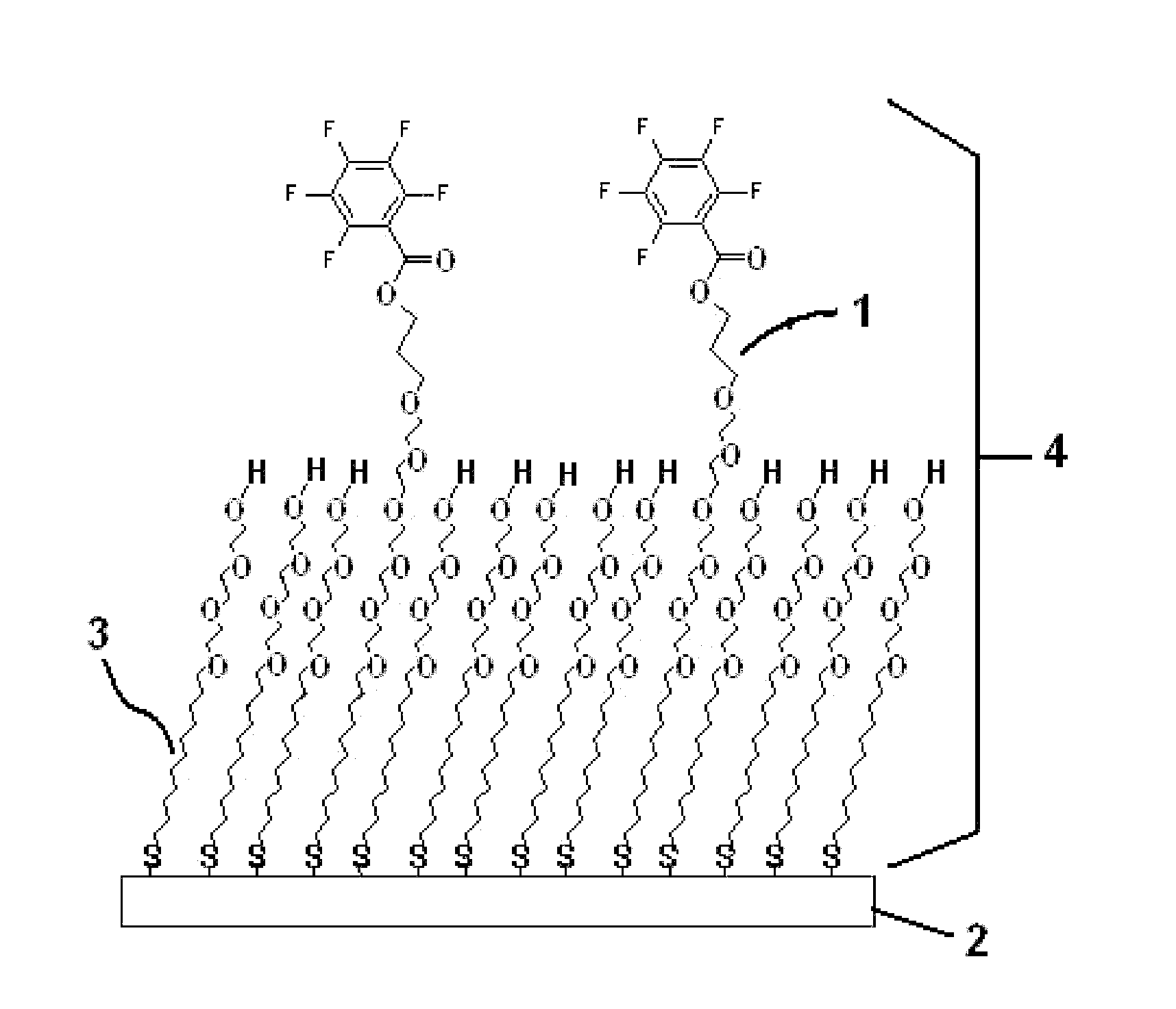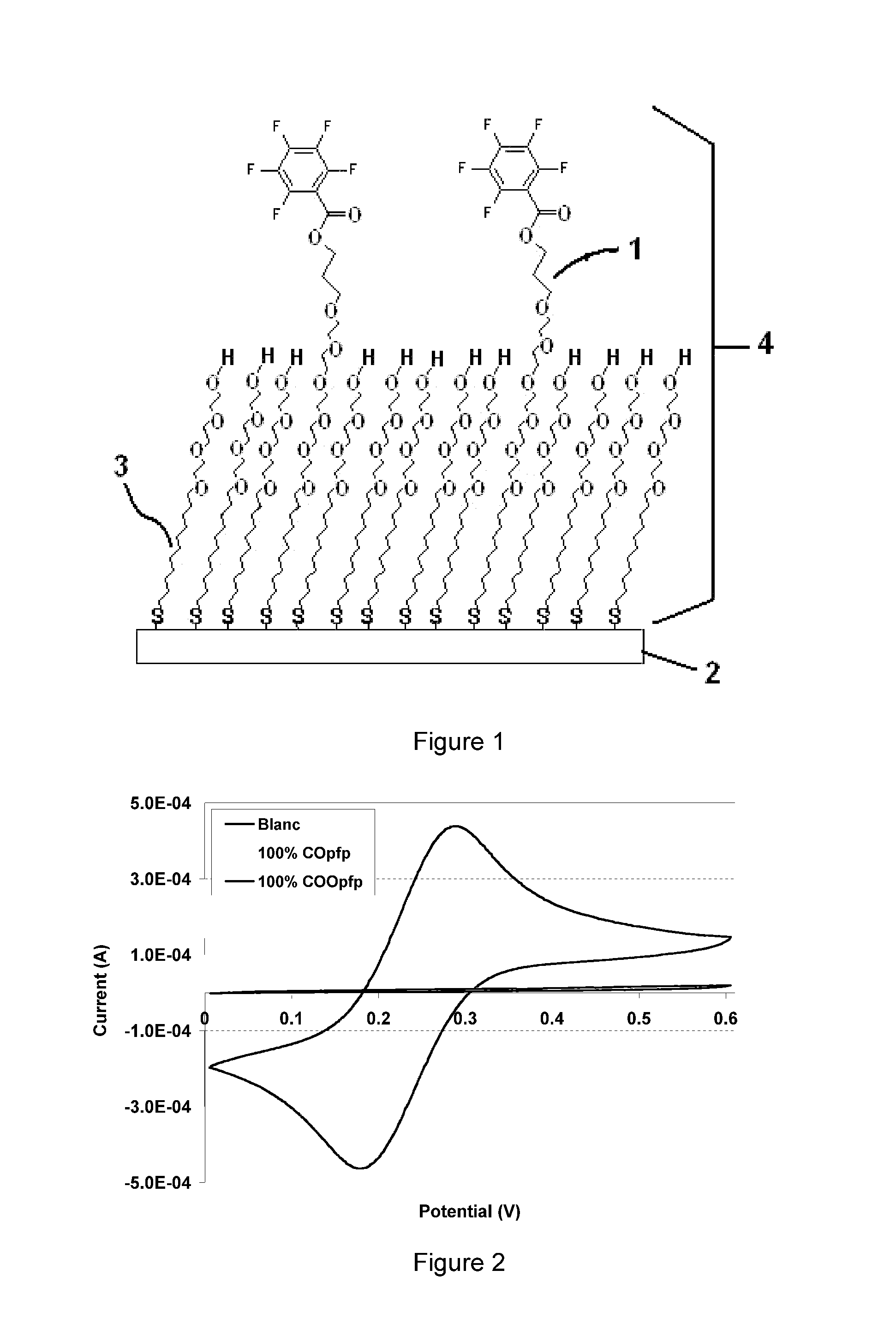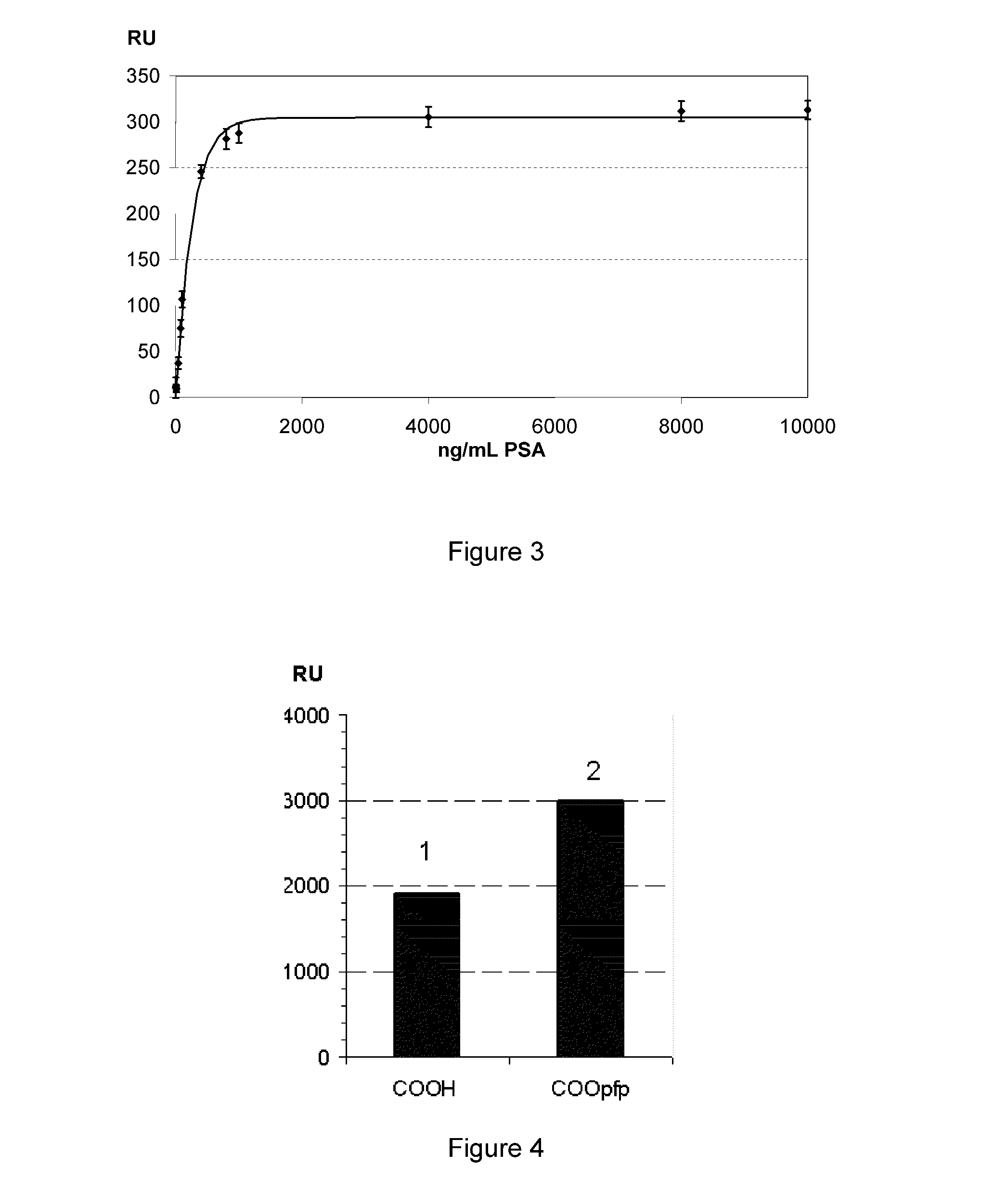Molecules suitable for binding to a metal layer for covalently immobilizing biomolecules
a biomolecule and metal layer technology, applied in the field of biosensors, can solve the problems of low final yield of immobilization degree, monolayers without poly(ethylene oxide) groups, and monolayers that cannot be incorporated into poly(ethylene oxide) groups, etc., and achieve high selectivity, high stability, and reproducibility high
- Summary
- Abstract
- Description
- Claims
- Application Information
AI Technical Summary
Benefits of technology
Problems solved by technology
Method used
Image
Examples
example 1
Synthesis of 2-{2-[2-(11-mercapto-undecyloxy)ethoxy]ethoxy}ethyl2,3,4,5,6-pentafluorobenzoate and analogues derived from higher polyethylene glycols
[0169]2-{2-[2-(11-mercapto-undecyloxy)ethoxy]ethoxy}ethyl-2,3,4,5,6-pentafluoro benzoate is an example of a compound (shown schematically below) of the general formula X1—(CH2)c—O—([CH2]t—CH2)n—O—R1—S—X2 wherein X1=fluorobenzoyl, t=1, c=0 and n=3.
[0170]The present molecule has been synthesized according to the following synthesis scheme:
[0171]A solution of 2-{2-[2-(undec-10-enyloxy)ethoxy]ethoxy}ethanol (n=3) (commercially available at Prochimia) in ethanol containing 4 molar equivalents of thioacetic acid and 10 mg of AIBN was irradiated under UV light for 6 hours under an atmosphere of nitrogen. The reaction mixture was concentrated by rotary evaporation at reduced pressure and purification by chromatography on silica gel.
[0172]A mixture of NaH and the thioacetate in THF / DMF was stirred for about 1 hour under an atmosphere of argon, an...
example 2
Synthesis of 2-(2-{2-[2-(11-mercapto-undecyloxy)ethoxy]ethoxy}ethoxy)methyl pentafluorophenoxycarbonyl (n=3) and analogues derived from higher polyethylene glycols
[0175]2-(2-{2-[2-(11-mercapto-undecyloxy)ethoxy]ethoxy}ethoxy)methyl pentafluorophenoxycarbonyl is an example of a compound (shown schematically below) of the general formula X1—(CH2)c—O—([CH2]t—CH2)n—O—R1—S—X2 wherein X1=pentafluorophenoxycarbonyl, c=1 and n=3.
[0176]The present molecule has been synthesized according to the following synthesis scheme:
[0177]NaH was added to a DMF / THF solution of 2-{2-[2-(undec-10-enyloxy)ethoxy]ethoxy}ethanol (n=3) (commercially available from Prochimia). The mixture was stirred for about 10 min. and tert-butyl bromoacetate was added dropwise. The mixture was stirred at RT overnight and was concentrated by rotary evaporation at reduced pressure and extracted with ethyl acetate and water. The reaction mixture was concentrated by rotary evaporation at reduced pressure and purification by chr...
example 3
Synthesis of 2-{2-[2-(11-mercapto-undecyloxy)ethoxy]ethoxy}ethoxy chloridocarbonyl (n=3) and analogues derived from higher polyethylene glycols
[0182]2-{2-[2-(11-mercapto-undecyloxy)ethoxy]ethoxy}ethoxy chloridocarbonyl is an example of a compound (shown schematically below) of the general formula X1—(CH2)c—O—([CH2]t—CH2—O)n—R1—S—X2 wherein X1=carbonyl chloride, c=0 and, X2=H, R1=(CH2)11.
[0183]A mixture of 1.5 molar equivalent NaH and 1 molar equivalent 2-{2-[2-(undec-10-enyloxy)ethoxy]ethoxy}ethanol (n=3) (commercially available at Prochimia) in 50 ml DMF was stirred for about 30 minutes under an atmosphere of argon, and then 1.5 molar equivalent of carbonyl dichloride was added. Next, the solution was stirred for 24 hours under an atmosphere of argon, followed by quenching with 25 ml methanol. The reaction mixture was then extracted with diethyl ether and water. The organic portion was dried over MgSO4 and concentrated by rotary evaporation at reduced pressure. The product was puri...
PUM
 Login to View More
Login to View More Abstract
Description
Claims
Application Information
 Login to View More
Login to View More - R&D
- Intellectual Property
- Life Sciences
- Materials
- Tech Scout
- Unparalleled Data Quality
- Higher Quality Content
- 60% Fewer Hallucinations
Browse by: Latest US Patents, China's latest patents, Technical Efficacy Thesaurus, Application Domain, Technology Topic, Popular Technical Reports.
© 2025 PatSnap. All rights reserved.Legal|Privacy policy|Modern Slavery Act Transparency Statement|Sitemap|About US| Contact US: help@patsnap.com



